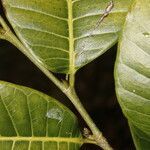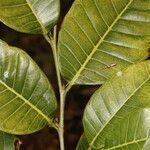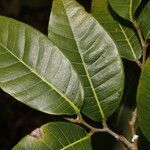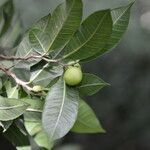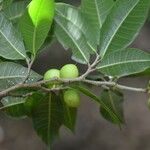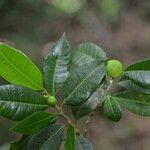A large evergreen tree. It grows to 25-30 m high. It has a dense wide crown of leaves. It has narrow buttresses. The bark is grey. The leaves are simple and dark green. They are 17 cm long by 6 cm wide. There can be teeth along the edge and often the edge is wavy. The flowers are in a round head. Most are male with a female flowers in the centre. The fruit is small, round and golden orange. The tree has small roundish yellow or brown seeds about 2 cm across. They occur singly or sometimes two in a thin paper-like shell. It has a smooth but granular surface.
Trees , to 30 m. Branchlets gray-brown, glabrous. Leaves: stipules clasping, ca. 4 mm; petiole 0.5-0.7 cm. Leaf blade 5-15 × 2-6 cm, base broadly obtuse to rounded, apex obtuse to short-acuminate, nearly cuspidate; surfaces abaxially and adaxially glabrous; veins 12-18 pairs. Inflorescences nearly globose, 3-6 mm diam.; peduncle slender, equal to or shorter than head. Staminate flowers: anther ca. 1 mm diam. Pistillate flowers: style 1.5-8.5 mm; stigmas 0.2-8 mm, unequal. Syncarps yellow, 1.5-2 cm diam.
centrally peltate and dehiscing circumscissilly, about 1 mm. in diameter. Fruit about 1.5 cm. in diameter.
